|
Before I start, allow me to pay reference to the title of this post. "Uppers, Downers, All Arounders," by Darryl S. S. Inaba, Michael E. Holstein, William E. Cohen was a book I read in graduate school. The title of the book is descriptive and catchy. I think it helps describe each piece of a Birkenstock that makes up the entire (all around) shoe: downers (the footbed) and uppers (the top of the shoe). The materials used in the footbed (the downers part of the title) were discussed in a previous post titled: Birkenstock: Original vs Soft Footbed. Birkenstock has been making shoes since 1774. Birkenstock uppers were traditionally made out of leather. Over the course of their 242 year history, Birkenstock has come up with additional high quality, non leather materials for their uppers. Having alternatives to leather uppers is intriguing for various reasons. The cost of synthetic uppers is significantly less than those made of leather. For those of us non-meat eaters, having a vegan option is quite appealing. Moreover, the Birkenstock shoes made with synthetic materials are snazzier: think sparkles, shine, and vibrant colors. Birkenstock offers great detail about the materials used when making their products. Please note that not all Birkenstocks are available in the US. There are many more choices available throughout Europe. Let’s talk a little about some of the materials that I have seen being sold in the US market: Leather Birkenstock uses top-grain cowhide for their leather uppers. The smooth finish is durable and easy to clean. One can easily clean and condition leather with a Leather Balm. Oiled Leather Oiled leather has a soft feel and is less shiny. It’s surface is durable and moisture-resistant. One can occasionally use beeswax to help maintain the leather. Nubuck Top-grain cowhide, buffed to create a soft, velvety finish. It is recommended that one spray the nubuck with a water and stain protector. To clean, brush the surface with a plastic bristle or leather cleaning brush. Be sure to re- apply with the water and stain protector after cleaning. Suede Made with premium cowhides. It is recommended that one spray the nubuck with a water and stain protector.. To clean, brush the surface with a plastic bristle or leather cleaning brush. Be sure to re- apply with the water and stain protector after cleaning. Wool Felt Genuine wool. Dense, retains shape and does not pill. Lightly spray with Scotchguard to protect the wool. Boiled Wool Boiled wool is pre-shrunk and feels very dense. Birkenstock states shoes with boiled wool uppers are highly durable, breathable, and warm. Birko-Flor This is the synthetic alternative from Birkenstock for leather. Birko-Flor is a smooth vinyl with a soft felt backing. This material is water-resistant and does not stretch or fade. There is no break-in required for Birko-Flor uppers. Clean this material with a wet washcloth. Birko-Flor Nubuck Birko-Flor nubuck is synthetic alternative for nubuck. This material is textured vinyl with a matte finish and soft felt backing. The material is water-resistant and does not stretch or fade. This is no break-in required for Birko-Flor uppers. Clean this material with a wet washcloth. Polyurethane This is tough, waterproof, biodegradeable synthetic. The polyurethane is resistant to heat, acid, oil, and grease. These shoes are easily cleaned with mild soap and water. EVA - Ethyl Vinyl Acetate This is a non-toxic synthetic material. It is lightweight and flexible. Footwear made from EVA is shock absorbent, is resistant to discoloration, is waterproof, is resistant to acid, oil, and grease. EVA is heat sensitive and there is a warning this material can shrink in heat over 170º F. I have some experience with most of the aforementioned materials listed and I would like to share my opinions with you. For the record, I have only tried on Birkenstocks with Wool Felt, EVA, and Polyurethane. I have not had any direct experience with the Boiled Wool or Birko-Flor Nubuck. Wool Felt I tried a Boston Birkenstock on with Wool Felt. I found the material very soft, not itchy, and warm. My concern with the wool felt was that it did not have an adjustable strap. If this material stretched out too much it might become uncomfortable. Polyurethane This material is used on the Super Birki’s. I ordered a pair that looked cute online, but when I tried them on I felt like I was wearing classic wooden Dutch clogs.
Ethyl Vinyl Acetate (EVA) I recently had the opportunity to try the EVA Arizona Birkenstocks on at Nordstrom. The material reminded me of that used by Crocs. It was soft, squishy, and had some arch support. Although, not nearly as much arch support as an original footbed Arizona. The EVA material is ideal if you plan to wear your Birkenstocks around water. Leather I have a pair of Arizona’s in brown Amalfi leather. The leather is thick, yet smooth. I find that this leather scratches easily. The leather looks old and worn, yet I have only had 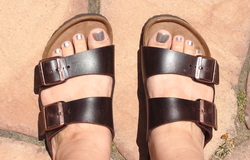 Birkenstock Arizona Brown Amalfi Leather Birkenstock Arizona Brown Amalfi Leather them for about a year. These were by far the most difficult Birkenstocks that I have ever had to break in. The leather eventually stretches and conforms to your foot. This is a thick leather and it has not stretched out as much as my nubuck or suede Birkenstocks (see below). Because the leather is thick it took me weeks to break these in. In fact, even after one year of wear, I was having some issues with the leather rubbing on a certain part of my foot (though I would never admit that to anyone). I found I was not wearing them as much as my nubuck Birkenstocks. One day, after walking several miles in them and getting a blister (again – would never admit that before this blog post) I decided to take some sandpaper and sand down the area that was giving me a hot spot. The sandpaper worked like a charm and I have not had another issue with this leather Birkenstock. They are back in the rotation. Oiled Leather My oiled leather Boston’s were the 2nd most difficult Birkenstocks to break in. 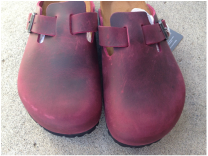 Birkenstock Boston Birkenstock Boston This leather is softer and smoother than the Amalfi leather and yet still very thick. I used socks to break in these Birkenstocks. I never got any hotspots thanks to the socks and it took 2-3 weeks before the leather conformed to my foot. These are now my favorite closed toed Birkenstocks. They feel like custom made shoes! 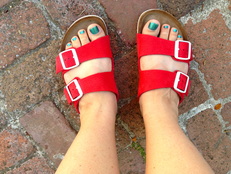 Birkenstock Arizona Nubuck Birkenstock Arizona Nubuck Nubuck The nubuck leather is thinner than the aforementioned leathers. This material stretches easily. Of all the leather Birkenstocks I own, these are the softest and quite easy to break in. However, I find that the nubuck continues to stretch and I occasionally have to add extra holes to tighten the straps. It’s not a problem (my dad has a leather hole punch), it’s just annoying. I sprayed these shoes with a stain guard before I ever wore them and I still got stains on the shoes. I have spent a lot of time using a leather brush to clean these shoes and recently bought Kiwi nubuck cleaner. The Kiwi Cleaner helped the most with freshening up the nubuck. Still, no matter how much I brush or clean the nubuck, they never seem totally clean. My biggest issue with the nubuck leather is how much it has faded. Last year these shoes were the perfect red. Today they are more pinkish red. Even though I love my red Arizona’s, I am not sure I would purchase another pair of Birkenstocks in nubuck. There is a lot of upkeep involved with nubuck and it easily fades. 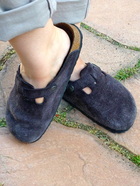 Boston Suede Boston Suede Suede I have a pair of suede Boston’s and they are fabulous. Soft, supple, breathable, and easy to wear right of out the box. I sprayed these shoes with a stain guard immediately and I waterproofed them. The suede has not faded. The only con would be that the suede does slightly stretch, but does not stretch as easily as the nubuck. I have had to add extra holes to my suede shoes, but only once. I wear these as my house slippers and can’t believe I waited 4 decades to own a suede pair of Birkenstocks. 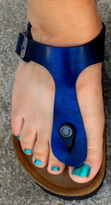 Gizeh Birko-Flor Gizeh Birko-Flor Birko-Flor I was skeptical when I ordered my first pair of Birko-Flor Birkenstocks. However, I was pleasantly surprised with the material. Birko-Flor is very soft on your foot because there is a lining of fleece on the underside. Making it fairly easy to wear right out of the box without risking blisters, like with the leather. The Birko-Flor material does not stretch like leather. You configure the straps to the width of your foot and you are all set. I have not needed to add extra holes like I have with the nubuck and suede. The best part is how easy it is to clean the Birko-Flor material. I use a wet cloth to wipe the uppers and the material is clean, it’s that easy. I have not experienced any fading with the Birko-Flor material. In addition, the material looks as new as it did a year ago. In my search for comfortable, supportive, and practical shoes I wanted to learn all I could so that I could make an informed purchase. I found it difficult to locate informational reviews about the different materials that Birkenstock offered. I hope that this post helps you decide what Birkenstock upper might be best for you. All Around – you can’t go wrong with any of the upper fabrics since they are all made from the highest quality materials by Birkenstock. Leather, Wool, Birko-Flor, or Birkubuck, the choice is yours. The fact that Birkenstock offers so many options is just another reason why I Love Birkenstocks! NOTE: Need tips on how to break-in leather Birkenstock straps? If so, read this blog. Comments are closed.
|
Gina MamaBirkenstock blogger Blog List
All
Archives
July 2024
|

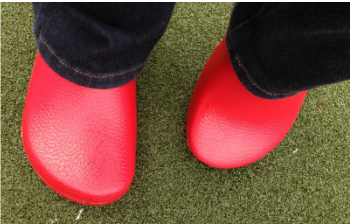
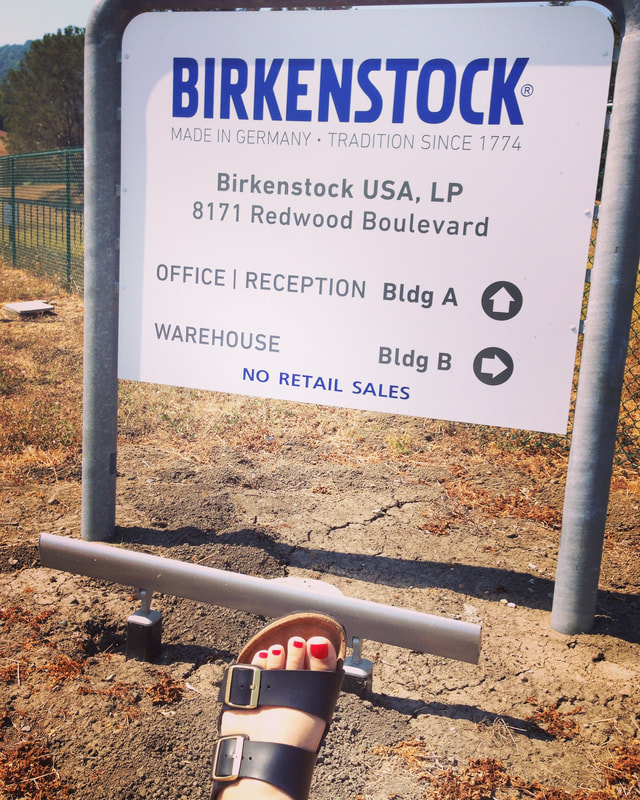
 RSS Feed
RSS Feed
